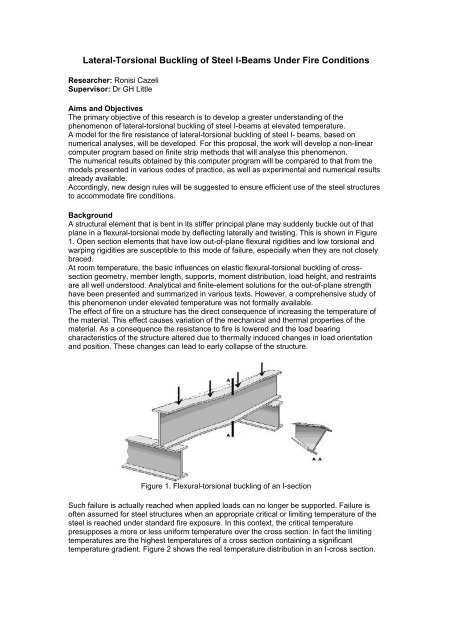Lateral-Torsional Buckling - University of Birmingham
Lateral-Torsional Buckling - University of Birmingham
Lateral-Torsional Buckling - University of Birmingham
Create successful ePaper yourself
Turn your PDF publications into a flip-book with our unique Google optimized e-Paper software.
<strong>Lateral</strong>-<strong>Torsional</strong> <strong>Buckling</strong> <strong>of</strong> Steel I-Beams Under Fire Conditions<br />
Researcher: Ronisi Cazeli<br />
Supervisor: Dr GH Little<br />
Aims and Objectives<br />
The primary objective <strong>of</strong> this research is to develop a greater understanding <strong>of</strong> the<br />
phenomenon <strong>of</strong> lateral-torsional buckling <strong>of</strong> steel I-beams at elevated temperature.<br />
A model for the fire resistance <strong>of</strong> lateral-torsional buckling <strong>of</strong> steel I- beams, based on<br />
numerical analyses, will be developed. For this proposal, the work will develop a non-linear<br />
computer program based on finite strip methods that will analyse this phenomenon.<br />
The numerical results obtained by this computer program will be compared to that from the<br />
models presented in various codes <strong>of</strong> practice, as well as experimental and numerical results<br />
already available.<br />
Accordingly, new design rules will be suggested to ensure efficient use <strong>of</strong> the steel structures<br />
to accommodate fire conditions.<br />
Background<br />
A structural element that is bent in its stiffer principal plane may suddenly buckle out <strong>of</strong> that<br />
plane in a flexural-torsional mode by deflecting laterally and twisting. This is shown in Figure<br />
1. Open section elements that have low out-<strong>of</strong>-plane flexural rigidities and low torsional and<br />
warping rigidities are susceptible to this mode <strong>of</strong> failure, especially when they are not closely<br />
braced.<br />
At room temperature, the basic influences on elastic flexural-torsional buckling <strong>of</strong> crosssection<br />
geometry, member length, supports, moment distribution, load height, and restraints<br />
are all well understood. Analytical and finite-element solutions for the out-<strong>of</strong>-plane strength<br />
have been presented and summarized in various texts. However, a comprehensive study <strong>of</strong><br />
this phenomenon under elevated temperature was not formally available.<br />
The effect <strong>of</strong> fire on a structure has the direct consequence <strong>of</strong> increasing the temperature <strong>of</strong><br />
the material. This effect causes variation <strong>of</strong> the mechanical and thermal properties <strong>of</strong> the<br />
material. As a consequence the resistance to fire is lowered and the load bearing<br />
characteristics <strong>of</strong> the structure altered due to thermally induced changes in load orientation<br />
and position. These changes can lead to early collapse <strong>of</strong> the structure.<br />
Figure 1. Flexural-torsional buckling <strong>of</strong> an I-section<br />
Such failure is actually reached when applied loads can no longer be supported. Failure is<br />
<strong>of</strong>ten assumed for steel structures when an appropriate critical or limiting temperature <strong>of</strong> the<br />
steel is reached under standard fire exposure. In this context, the critical temperature<br />
presupposes a more or less uniform temperature over the cross section. In fact the limiting<br />
temperatures are the highest temperatures <strong>of</strong> a cross section containing a significant<br />
temperature gradient. Figure 2 shows the real temperature distribution in an I-cross section.
Figure 2. Temperature field in an I-cross section, fire on all sides.<br />
Methodology<br />
This study will analyse simply supported steel I-beams (the end can not deflect laterally or<br />
twist), with two planes <strong>of</strong> symmetry shown in Figure 3.<br />
Figure 3. Simply supported beam.<br />
Figure 4. I-Beam divided by strip<br />
method.<br />
To analyse the behaviour <strong>of</strong> these steel I-beams under fire conditions, a finite strip analysis<br />
computer program has been developed. This method assumes that the cross section is<br />
divided in a required number <strong>of</strong> plates (Figure 4), and that the material properties as well as<br />
the temperature effect are considered for each individual plate along the length.<br />
Using finite element s<strong>of</strong>tware based on a non-linear analysis, a finite element modelling <strong>of</strong> the<br />
complete collapse behaviour <strong>of</strong> I-beams at high temperatures will also be developed.<br />
The calculation models employed on those computer programmes briefly cited above, allow a<br />
precise mechanical and thermal simulation. These may be used to solve two different<br />
problems. Firstly the behaviour at room temperature with a step-by-step increase <strong>of</strong> the static<br />
load, and secondly the behaviour at elevated temperatures with static and thermal<br />
calculations as a function <strong>of</strong> the fire duration time. This process makes it possible to consider<br />
any geometric non-linear effects, which must be considered when buckling is involved.<br />
Main References<br />
BRISTISH STANDARD INSTITUTION 1990. BS5950-8: Structural use <strong>of</strong> steelwork in<br />
building. Part 8: Code <strong>of</strong> practice for fire resistant design. BSI. London.<br />
CAZELI, Ronisi ; VILA REAL, Paulo M. M.; SILVA, Valdir Pignatta ; PILOTO, PAULO 2001.<br />
Análise numérica de vigas I de aço em situação de incêndio, sujeitas à flambagem lateral.<br />
Contribuição para a validação de uma proposta de revisão do Eurocode 3 - Parte 1.2. IV<br />
International Seminar on the Use <strong>of</strong> Steel Structures in Civil Construction, and I International<br />
Conference on Steel Construction - I CICOM. November. São Paulo, SP, Brazil.<br />
EUROPEAN STANDARD EUROCODE. ENV 1993-1-2. EUROCODE 3: Design <strong>of</strong> Steel<br />
Structures - Part 1-2: General Rules - Structural fire design. CEN. Brussels.<br />
FRANSSEN, J. M. 1996. PROGRAM SAFIR, Ver. 1.3, User`s Manual. Universite de Liège,<br />
Institut du Genie Civil, Service. Liege.
SILVA, Valdir Pignatta 2001. Estruturas de Aço em Situação de Incêndio. São Paulo, SP,<br />
Brazil. Zigurate Editora.<br />
Wittrick, W. H.; Williams, F. W. 1973. User's Guide to VIPASA (Vibration and Instability <strong>of</strong><br />
Plate Assemblies including Shear and Anisotropy). A computer program developed in the<br />
Department <strong>of</strong> Civil Engineering <strong>of</strong> the <strong>University</strong> <strong>of</strong> <strong>Birmingham</strong>. January.







![Benyamin Asadipour-Farsani [EngD Conference abstract]](https://img.yumpu.com/51622940/1/184x260/benyamin-asadipour-farsani-engd-conference-abstract.jpg?quality=85)









